Boggs S. Principles of Sedimentology and Stratigraphy
Подождите немного. Документ загружается.

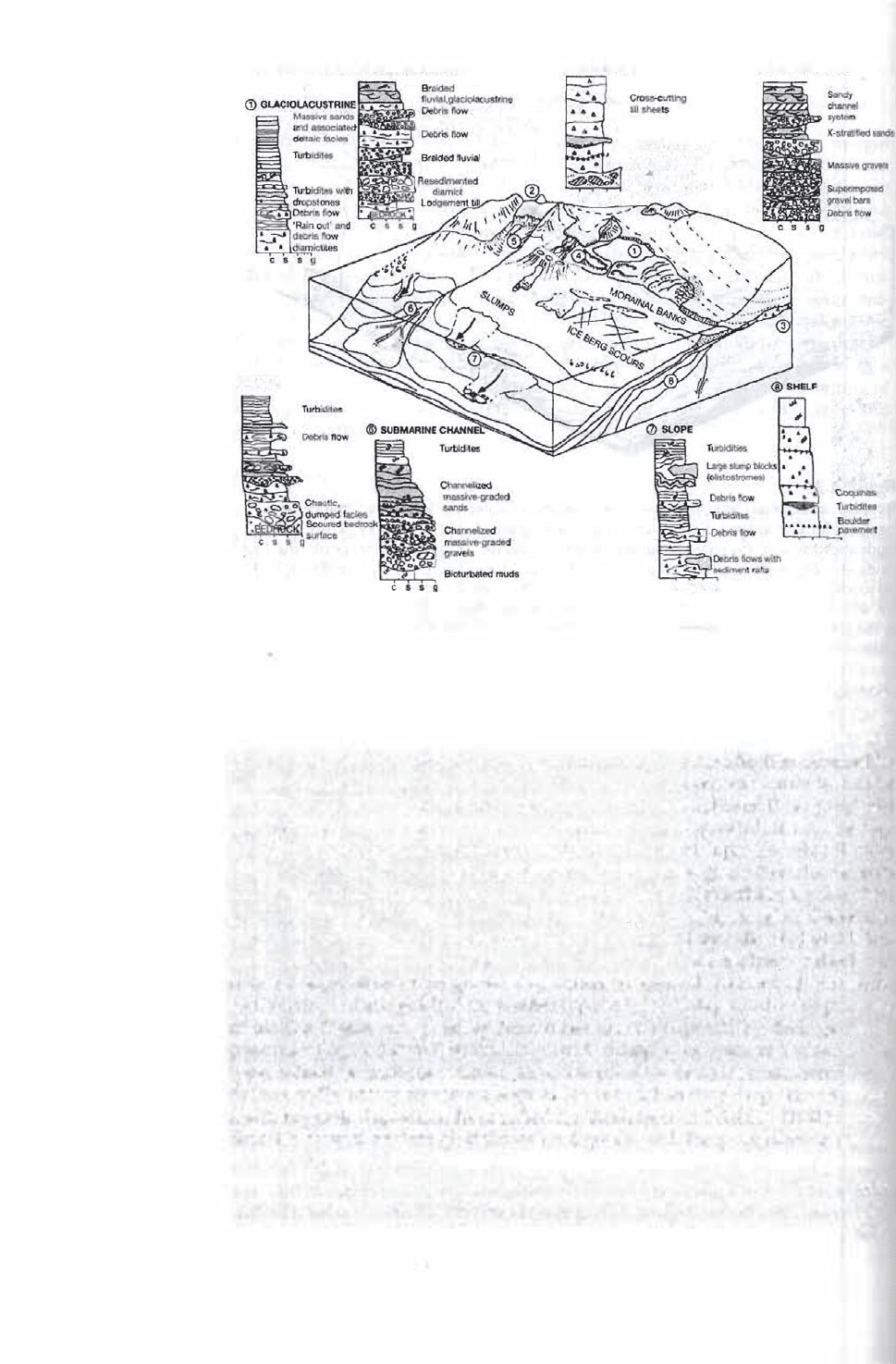
286
Chapter 8 I Continental (Terrestrial) Environments
Figure 8.35
Typical vertical profiles of
facies deposited during a
single phase of glacial ad
vance and retreat in various
parts of the glacioterrestrial
and glaciomarine setting; c,
s, s, g = clay, silt, sand,
gravel. [From Eyles, N., and
C. H. Eyles, 1992, Glacial
depositional systems, in R.
G. Walker and N. P. james
(eds.), Facies models: Geo
logical Association of Cana
da, Fig. 3, p. 74,
reproduced by permission.]
GLACIATED VAlLEY
$ FIOAD
Ancient Glacial Deposits
@ SUBGLACIAL
I t
l
ll
�wt
c • � g
c 6 s
GLACFLUVIAL
�t
di
l•
-
�
-
�
c " 5 g
Glacial deposits range in size from small bodies deposited by valley glaciers to
till sheets, deposited by continental glaciers, that cover many thousands o
f
square kilometers. The most characteristic feature of continental tills, or ground
ed-ice facies, is their extremely poor sorting and lack o
f
stratification. Ancient fa
cies of glaciofluvial, glaciolacustrine, and glaciomarine environments tend to be
better stratified and better sorted. Because the characteristics of these proglacial
sediments reflect the environment in which they are deposited, it may be yery
difficult in ancient stratigraphic successions to distinguish proglacial sediments
from other types of continental sediments. For example, glaciofhnrial sediments
may appear much the same as other fluvial sediments. Nevertl1eless, a few char
acteristics of these deposits may reveal their relationship to glacial ewiron
ments. As mentioned, the presence of varves may be diagnostic ot laciallakes,
and abrupt changes in sediment size related to variable metwater diharge
may be suggestive of proglacial deposition in generaL Ancient glaciomarine
sediments are distinguished from other types of glac ial deposits by the presence
of marine fossils and possibly from other marine deposits by their generally
prer sorting and stratification. They tend to display extreme variation in clast
ype, refleoting multiple sources. Also, the presence of dropstones, which may
deform sedimentary structures such as laminae when they drop into soft sedi
ment, suggests deposition from rafted ice. Anderson and Ashley (1991) further
describe several ancient glacial-marme deposits and the palelimatic signifi
cance of these sediments.
Ancient glacial deposits are best known from sedimentary units of Pleis
tocene age, which are widespad many parts of the world. At least four major
pulses of continental glaciation occurred during the Pleistocene, plus numerous

Further Reading
287
smaller pulses. Extensive continental glaciation appears to have been important also during the late Precam
brian and early Proterozoic, late Ordovician, and late Paleozoic. Carboniferous to Permian glacial deposits are
known
from South America, southe Africa, Antarctica, India, and Australia. Late Ordovician diamictons
have been reported from South America, several parts of Africa, and possibly Ethiopia. Late Precambrian de
posits
are known on all continents except Antarctica, and early Proterozoic glacial sediments have been re
por
ted in North America in a belt extending from Wyoming to Quebec.
FURTHER READING
Auvial Systems
Best, J. L, and C. S. Bristow (eds.), 1993, Braided rivers: GeoL
Soc. London Spec Pub!. 75, Bristol, 432 p.
Bridge, J. S., 2003, Rivers and floodplains: Blackwell Science Ltd.,
Oxford, 491 p.
Collinson, J. D., and J. Lewin (eds.), 1983, Modern and ancient
fluvial systems: Int. Assn. Sedimentologists Spec. Pub!. 6,
Blackwell Scienfic Publications, Oxford, 575 p.
Ethridge, G., and R. M. Flores (eds.), 1981, Recent and ancient
nonmarine depositional environments: Part II: Alluvial fan
and fluvial deposits: Soc. Econ. Paleontologists and Mineralo
gists, Spec. Pub. 31, Tulsa, Okla., p. 49-212.
Ethridge, G., R. M. Flores, and M.D. Harvey (eds.), 1987, Re
cent developments in fluvial sedimentology: Soc. Econ. Pale
oatologists and Mineralogists, Spec. Pub. 39, Tulsa, Okla.,
389 p.
Fielding, C. R. (ed.), 1993, Current research in fluvial sedimentol
ogy: Special Issue of Sedimentary Geology, v. 85, 656 p.
Flores, R. M., G. Ethridge, A. D. Miall, W. E. Galloway, and T.
D. Fouch, 1985, Recognition of uvial depositional systems
and their resource potential: Soc. Econ. Paleontologists and
Mineralogists Short Course Notes 19, Tulsa, Okla., 290 p.
Fraser, G. S., and L. Suttner, 1986, Alluvial fans and fan deltas: In
teational Human Resources Development Corporation,
Boston, 199 p.
Marzo, M., and C. Puigdefabregas (eds.), 1993, Alluvial sedimen
tation, Special Publication o. 17, International Association
of Sedimentologists: Blackwell Science, Oxford, 586 p.
Mia, A D., 1996, The geology of fluvial deposits: Springer-Verlag,
New York, 586 p.
Miall, A. D., and N. 'Tyler (eds.), 1991, Three-dimensional facies
architecture of terrigenous clastic sediments and its implica
tions for hydrocarbon discovery and recovery: Concepts in
Sedimentology and Paleontology 2, SEPM (Society for Sedi
mentary Geology), Tulsa, Okla. 309 p.
Niln, T. H. (ed.), 1984, Fluvial sedimentation and related tectonic
framework, weste North America: Sed. Geology, v. 36, 523 p.
North, C. P. , and D. J. Prosser (eds.), 1993, Characterization of
fluvial and aeolian reservoirs: Geological Society Special Pub
lication 73, Geological Society London, 450 p.
Rachocki, A., 1981, Alluvial fans: John Wiley & Sons, New York,
161 p.
.
chocki, A. H., and M. Church (eds.), 1990, Alluvial fans: John
Wiley & Sons, Chichester and New York, 391 p.
Smith, N.D., and J. Rogers, 1999, Fluvial Sedimentology VI, Spe
cial Publication No. 28, Inteational Association of Sedimen
tologists: Blackwell Science, Oxford, 478 p.
Eolian Systems
Badorff-Nielsen, 0. E., and B. B. Willets (eds.), 1991, Aeolian
ain transport-1 mechanics: Springer-Verlag, Wien, New
York, 181 p.
Fryberger, S. G., L Krystinik, and C. J. Schenk, 1990, Modern
and ancient eolian deposits: Petroleum exploration and pro
duction: Rocky Mountain Section, SEPM, Denver, various
pagination. ·
Glennie, K. W., 1970, Desert sedimentary environments: Devel
opments in sedimentology 14, Elsevier, Amsterdam, 222 p.
Goudie, A. S., L Livingstone, and S. Stokes (eds.), 1999, Aeolian
environments, sediments and landforms: John Wiley & Sons,
Ltd., Chichester, 325 p.
Hesp, P. A. (ed.), 1998, Eolian environments: Special issue of Ge
omorphology, v. 22. p. 111-204.
Kocurek, G. (ed.), 1988, Late Paleozoic and Mesozoic eolian de
posits of the western interior of the United States: Special
Issue of Sed. Geology. v. 56, 413 p.
Kocurek, G., 1991, Interpretation of ancient eolian sand dunes:
Ann. Rev. Earth and Planetary Sciences, v. 19, p. 43-75.
North, C. , and D. J. Prosser (eds.}, 1993, Characterization of flu
vial and aeolian reservoirs: Geological Society Special Publi
cation 73, Geological Society London, 450 p.
Pye, K. (ed.), 1993, The dynamics and environmental context of
• aeolian sedimentary systems: Geological Society Special Pub
lication 72, Geological Society London, 332 p.
Pye, K., and N. Lancaster (eds.), 1993, Aeolian sediments: An
cient and mode: International Association of Sedimentolo
gists Special Publication 16: Blackwell Scientific Publications,
Oxford, 167 p.
Pye, K., and H. Tsoar, 1990, Aeolian sand and sand dunes: Unwin
Hyman, London, 396 p.
Lacustrine Systems
Anad6n, P. , L. I. Cabrera, and K. Kelts (eds.), 1991, Lacustrine fa
cies analysis: Internat. Assoc. Sedimentologists Spec. Pub. 13,
Blackwell, Oxford, 318 p.
Gierlowski-Kordesch, E., and K. Kelts (eds.), 1994, Global geo
logical record of lake basins, v. 1: Cambridge University
Press, 427 p.
Gierlowski-Kordesch, E. H., and K. R. Kelts (eds.), 2000, Lake
basins through space and time: AAPG Studies in Geology
No. 46, 648 p.
Lerman, A., D. Imboden, and J. Gat (eds.), 1995, Physics and
chemistry of lakes, 2nd ed.: Springer-Verlag, Berlin, 334 p.
Noe-Nygaard, N. (ed.), 1998, Limno-geology-Research and
methods in ancient and modern lacustrine basins: Special
issue of Palaeogeography, Palaeoclimatology, Palaeoecology,
v. 140, p. 1-478.
Renaut, R. W., and W. M. Last, 1994, Sedimentology and geo
chemistry of mode and ancient saline lakes: SEPM (Society
for Sedimentary Geology) Spec. Pub!. 50, Tulsa, Okla., 334 p.
Glacial Systems
Anderson, J. B., and G. M. Ashley (eds.), 1991, Glacial marine
sedimentation; Paleoclimatic significance: Geol. Soc. America
Spec. Paper 261, 232 p.

288 Chapter 8 I Continental (Terrestrial) Environments
Brodzikowski, K., and A. j. van Loon, 1991, Glacigenic sedi
ments: Elsevier, Amsterdam, 674 p.
Dowdeswell, j. D., and j. D. Scourse (eds.), 1990, Glaciomarine
en\·ironments: Processes and sediments: Geol. Soc. London
Spc. Pub. 53, 423 p.
French, H. M., 1996, The periglacial environment, 2nd ed.: Addi
son Wesley Longmen Ltd., Edinburgh Cote, Harlow, 341 p.
Hombrey, M., 1994, Clociill environments: UCL Press Ltd., Lon
don, 296 p.
Jopling, A. , ilnd B. C. McDonald, 1975, Glaciofluvial and
glaciolacustrine sedimentation: Soc. Econ. Paleontologists
and Minerologist Special Pub. No. 23, 320 p.
Knight, G., 1999, Glaciers: Stanley Thomes (Publishers) Ltd.,
Cheltenham, 261 p.
Martini, I. P., M. E. Brookfield, and S. Sadura, 2001, Principles of
glacial geomorphology and geology: Prentice Hall, Upper
Saddle River, N.)., 381 p.
Menzies, j. (ed.), 1995, Modern glacial environments: Processes,
dynamics and sediments: Butterworth-Heinemann, Oxford,
621 p.
Menzies, j. (ed.), 1996, Past glacial environments: Butterworth
Heinemann, Oxford, 598 p.
Piotrowski, j. A. (ed.), 1997, Subglacial environments: Special
issue of Sedimentary Geology, v. 111, 327 p.

Marginal-Marine Environments
9.1 INTRODUCTION
T
he marginal-marine setting lies along the boundary between the continental
and the marine depositional realms. It is a narrow zone dominated by river,
wave, and tidal processes. Salinities may range in different parts of the sys
tem from fresh through brackish to supersale water, depending upon river dis
rge and climatic conditions. Intermittent to nearly constant subaerial exposure
aracterizes some environments of the marginal marine setting. Others are con
tinuously covered by shallow water. Many marginal-marine environments are
further characterized by high-energy waves and currents, although some lagoonal
and estuarine environments are dominated by quiet-water conditions.
Because of the large quantities of siliciclastic sediment delivered by rivers to
e coastal zone throughout geologic time, the volume of marginal marine de
posits preserved in the geologic record is significant. The principal depositional
settings for marginal-marine sediments are deltas; beaches, strand plains, and bar
rier bars; estuaries; lagoons; and tidal flats (Fig. 9.1). Estuaries and lagoons are
particularly characteristic of transgressive coas; deltas are features of prograding
csts. A wide variety of sediment types-including conglomerates, sandstones,
shales, carbonates, and evaporite-can accumulate in these various marginal
marine environments. We begin study of these environments by examining first
deltas,
followed, in turn, by beach and barrier-island systems, estuaries, and
lagoons.
9.2 DELTAIC SYSTEMS
Introduction
e
word delta was used by the Greek philosopher Herodotus about 490 B.C. to
describe the triangular-shaped alluvial plain formed at the mouth of the Nile
River by deposits of the Nile distributaries. Most mode deltas are less triangular
and more irregular in shape an the Nile delta (e.g., Fig. 9.2). Nevertheless, the
rm (alluvial) delta is still applied to any deposit, subaerial or subaqueous,
formed by fluvial sediments that build into a standing body of water. Deltas are
289
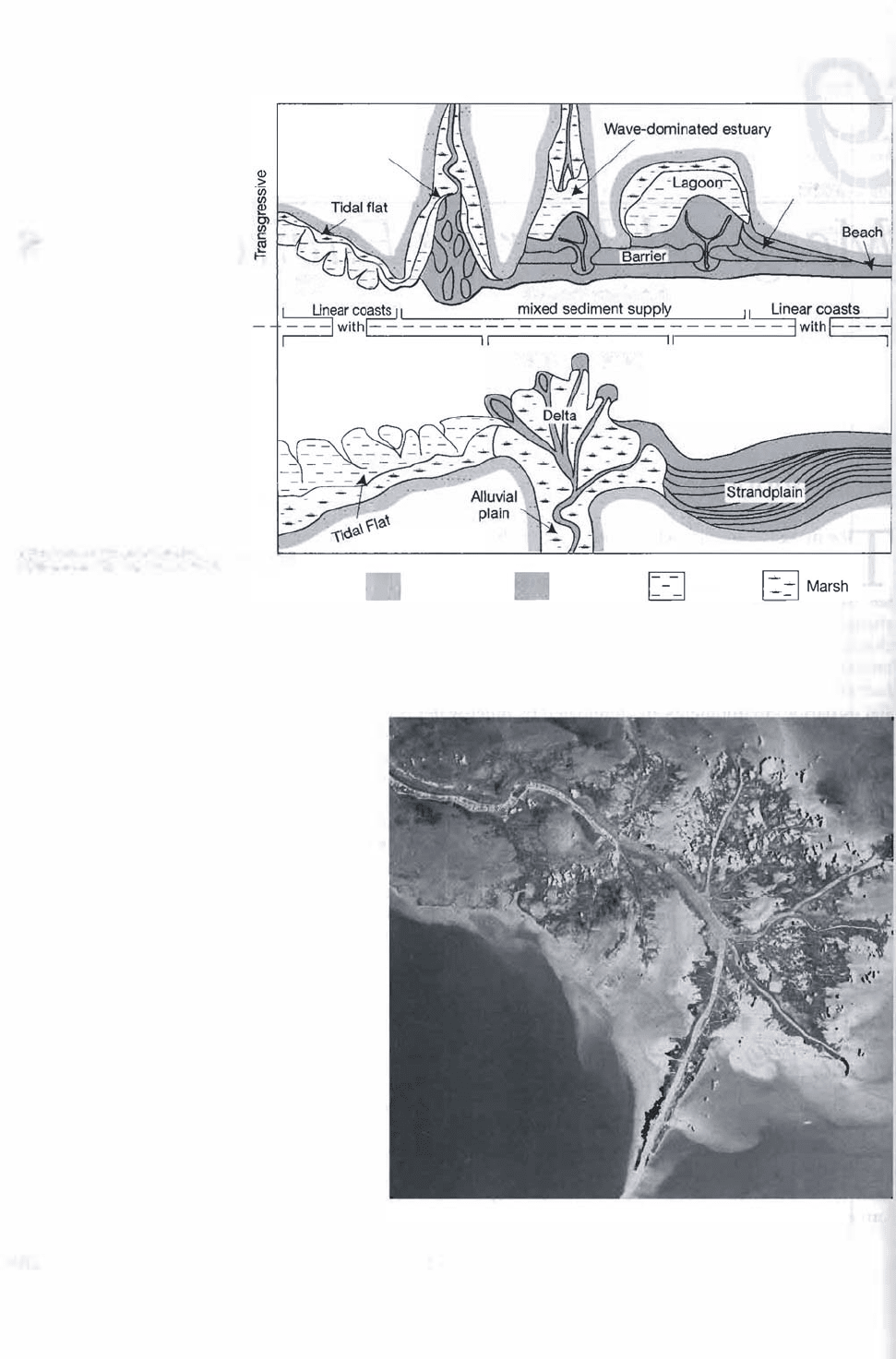
290
Chapter 9 I Marginal-Marine Environments
Figure 9.1
The principal coastal environ
ments of the marginal-marine
depositional setting. The fig
ure is organized to show the
relative influence of tidal
power (increasing to the left)
and wave power (increasing
to the right) on each environ
ment. Note that deltas are
features of prograding (re
gressive) coasts, whereas estu
aries and lagoons are
particularly characteristic of
transgressive coasts. [From
Boyd et al., 1992, Classifica
tion of clastic coastal deposi
tional environments: Sed.
Geology, v. 80, Fig. 2, p. 141,
reproduced by permission.]
Figure 9.2
c
�
e
>
'i
�
Increasing relative tidal power - -----
----- Increasing relative wave power
Tide
dominated
estuary
_- �-oo -_ .·
Strandplain
Sea
--- -
Q Embayed coasts with
I
:-_:i I_------_----:i-f
marine sediment supply
11 Elongate/lobate
coasts with
11
marine sediment supply
D Land
river
sediment supply
Sea
O sand
I= --1
Mud ���� Marsh
The Misissippi River Delta, Gulf of Mexico.
Image courtesy of NASA Landsat Project Sci
ence Office and USGS EROS Data Center.
Downloaded from the Internet 4/19/04.

9.2 Deltaic Systems
291
"discrete shorele protuberances formed where rivers enter oceans, semi-enclosed
seas, lakes or lagoons and supply sediment more rapidly than it can be redistrib-
uted by basinal processes" (Elliott, 1986a). Thus, deltas can form in lakes and -
land seas as well as in the ocean, but they are most important in the open ocean.
Much of the siliciclastic sediment traported to coastal zones throughout geologic
time has been deposited in deltas.
Ancient deltaic deposits have been identified in stratigraphic successions of
many ages, and deltaic sediments are known to be important hosts for petroleum
and natural gas, coal, and some minerals such as uranium. Although ancient
deltaic sediments are common in the rock record, much of what we know about
delta systems comes from study of modern deltas. Deltas are particularly common
the modern ocean owing to post-Pleistocene sea-level rise coupled with high
sediment loads carried by many rivers. High sea level increases sedimentation
rates on deltas because sediment is trapped by the rising water, inhibiting sedi
ment removal by currents. The locations, dimensions, and discharge characteris
tics of some modern deltas are given in Table 9.1.
Mode deltas occur on all continents, with the possible exception of Antarc
tica. (Trough-mouth, glacially influenced submarine fans are present on the Wed
dell Sea continental margin of tarctica; however, these fans may not be true
deltas.) Deltas form where large, active drainage systems with heavy sediment
loads exist. These conditions appear to be met particularly well on trailing-edge or
passive coasts such as the east coasts of Asia and the Americas where tectonic ac
tivity is low. Fewer than 10 percent of major mode deltas occur on collision
coasts, where tectonic activity is high and drainage divides are close to the sea
(Inman and Nordsom, 1971; Wright, 1978). Under such conditions, the large
drainage systems necessary to supply heavy sediment loads are not developed.
eir potential importance as oil and gas reservoirs has generated considerable in
terest in deltaic deposits since the 1950s. Consequently, e literature on deltas and
Delta-plain
Delta
Location
area (km2)
Alta
Norway-Alta Fiord
10
Burdekin
Queensland, Aust.-Pacific
2112
Copper
U.S.-Gulf of Alaska
1920
Ganges-Bramaputra
India & Pakistan-Bay of Bengal
105,641
Irrawaddy
Bua-Gulf of Martaban
20,571
Mackenzie
Terr., Canada-Beaufort Sea 13,000
Mahakam Indonesia-Makassar Strait
5000
Mississippi
U.S. -Gulf of Mexico 28,568
Niger
Nigeria-Gulf of Guinea 19,135
Weste Australia-Timor Sea
3,896
Punta Gorda
Belize-Gulf of Honduras
0.4
io Francisco Brazil-Atlantic
734
Skdarar Sandur
Iceland-North Atlantic
600
Yallahs
Jamacia-Caribbean Sea
10.5
Data source: ton and Readin
g
, 1993
Annual
Annual
water
sediment
discharge
discharge
(m3/sec)
(tons X
10
6
)
?
?
475
?
1236
70
30,769
1,670
13,562 265
9,100
126
?
16
15,631
349
8,769
40
163
22
?
?
3420
6
400
?
17.5
?
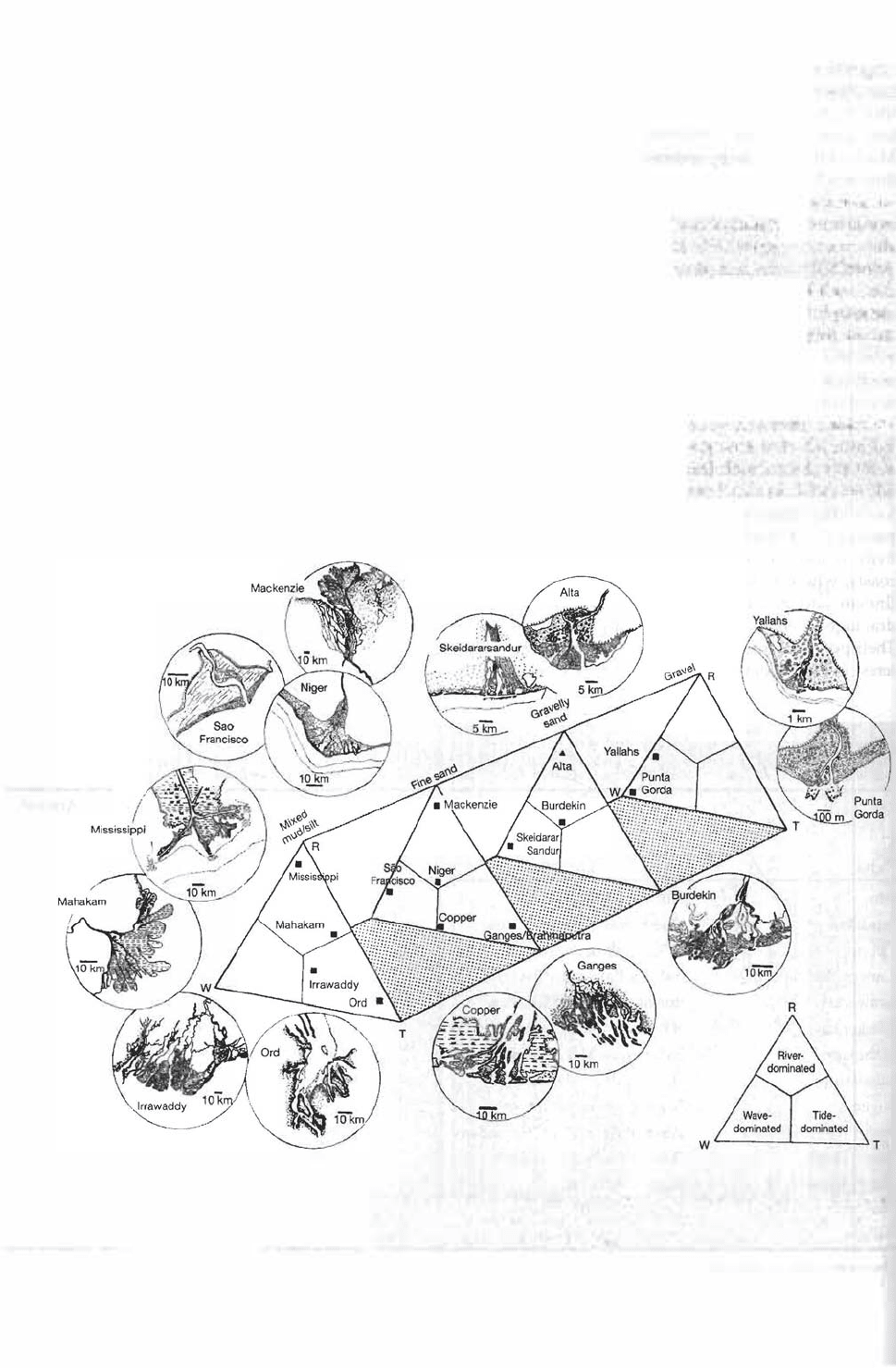
292 Chapter 9 I Marginal-Marine Environments
deltaic deposits is extensive. The volumes listed w1der "Further Reading-Deltaic
Systems" at the end of ts chapter provide a starting point for further literature re
search.
Delta Classification and Sedimentation Processes
The distribution and characteristics of deltas are controlled by a complex set of in
terrelated fluvial and marine/lacustrine processes and environmental conditions.
These factors include climate, water and sediment discharge, river-mouth
processes, nearshore wave power, tides, nearshore currents, and winds (Coleman,
1981). Other factors that influence the formation of deltas are slope of the shelf,
rates of subsidence and other tectonic activity at the depositional site, a11d geome
try of the depositional basin. Among these variables, river (sediment) input,
wave-energy flux, and tidal flux are the most important processes that control the
geometry, trend, and internal features of the progradational framework sand bod
ies of deltas (Galloway and Hobday, 1983).
Deltas can be classified in several ways (Nemec, 1990);
h
owever, classifica
tion on the basis of delta-front regime (Galloway, 1975) appears to be favored y
most geologists. Deltas are classified thus as (1) fluviaE-d0minated, (2) tide
dominated, or (3) wave-dominated (Fig. 9.3). Each of the kinds of deltas can be
Figure 9.3
Classification of deltas on the basis of dominant process of sediment dispersal at the delta
front, and the prevailing grain size of sediment delivered to the front. Dispersal processes;
R, river; W, wave; T, tidal. The insets illustrate the shapes of selected modern deltas plotted
in the classification diagram; see Ta ble 9. 1 for their locations. [After Orton, G. J., and H. G.
Reading, 1993, Variability of deltaic processes in terms of sediment supply, with particular
emphasis on grain size; Sedimentology, v. 40, Fig. 1, p. 477, reproduced by permission.]
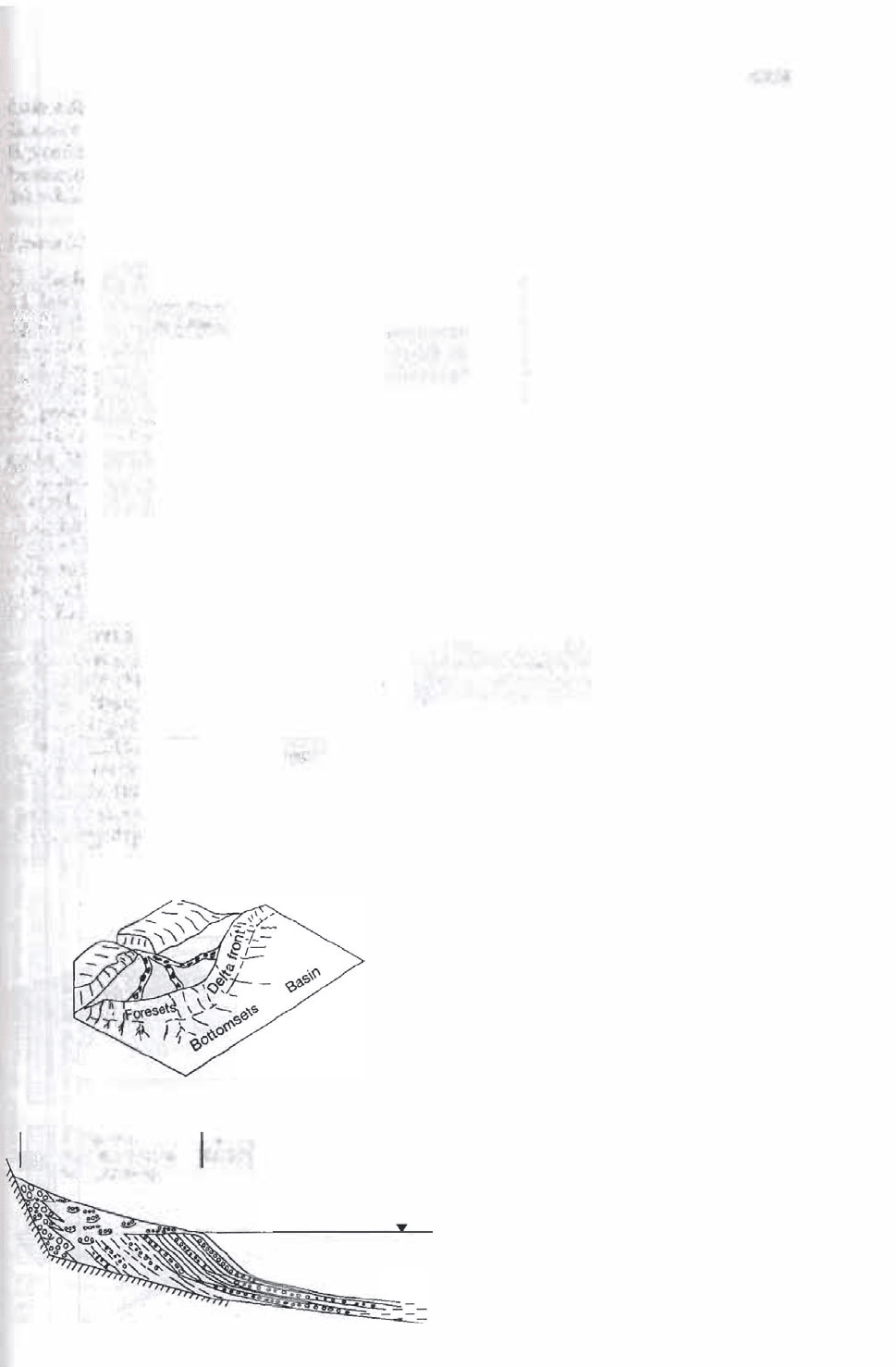
9.2 Deltaic Systems
293
further distinguished on the basis of dominant grain size of sediments (Orton, 1988;
Orton and Reading, 1993), that is, mud/silt, fine sand, gravelly sand, or gravel.
Figure 9.3 shows selected modern examples of each of these kinds of deltas. The
lations, areal extents, and discharge characteristics of these deltas are listed in
Table 9.1.
Fluvial-Dominated Deltas
The discharge of river water and sediment into a lake or ocean is referred to as a
jef. Bates (1953) contrasted the behavior of sediment-laden river water as it enters
equally dense, more dense, and less dense basin water. ver water entering basin
water of almost equal density, referred to by Bates as homopycnal flow, leads to
rapid, thorough mixing and abrupt deposition of much of the sediment load. This
ty of jet outflow is particularly common at the mouths of coarse-grained rivers
and presumably causes the formation of Gilbert-type deltas that display a topset,
foreset, and bottomset arrangement of beds, created as sediment deposition pro-
,grades basinward (Fig. 9. 4). River water that has higher density than basin water
flows beneath the basin water, commonly during floods, generating a vertically
oriented, plane-jet flow called hyperpycnal flow. This type of jet flow moves
along the bottom as a density current that deposits its load along the more gentle
slopes of the delta front to form turbidites. If river outflow is less dense than basin
water, as in rivers that flow into denser seawater or a saline lake, it flows outward
on top of the basin water as a horizontally oriented plane jet called hypopycnal
flow. Fine sediment may thus be carried in suspension some distance outward
fro m the river outh before it flocculates and settles from suspension. [Floccula
tion involves aggregation of fine sediment into small lumps owing to the presence
of positively charged ions in seawater that neutralize negative charges on clay
particles.] Hypopycnal flow tends to generate a large, active delta-front area, typ
ically dipping at 1 o or less, as contrasted with the 10°-20° dip of most Gilbert-type
deltas (Miall, 984). Hypopycnal fl9w)s probably the most important type of river
outow marine basins.
Wright (1977) suggested that the characteristics of delta sediments de
posited by river-mouth processes in coastal areas with low tidal range and low
wave energy depend upon the relative dominance of (1) outflow inertia (velocity),
Topsets
Proximal fan delta to
Transiti ze
I
Foresets
I
Bottomsets
I
Della front Prodelta
I
Basin
MWL
Figure 9.4
Schematic representation of a Gilbert-type delta. [From
Reading, H. G., and j. D. Collinson,
1
996, Clastic coasts, in
Reading, H. G. (ed.), Sedimentary environments: Process
es, facies and stratigraphy, 3rd ed. , Blackwell Science, Ox
ford, Fig. 6.22, p. 174, Reproduced by permission.]
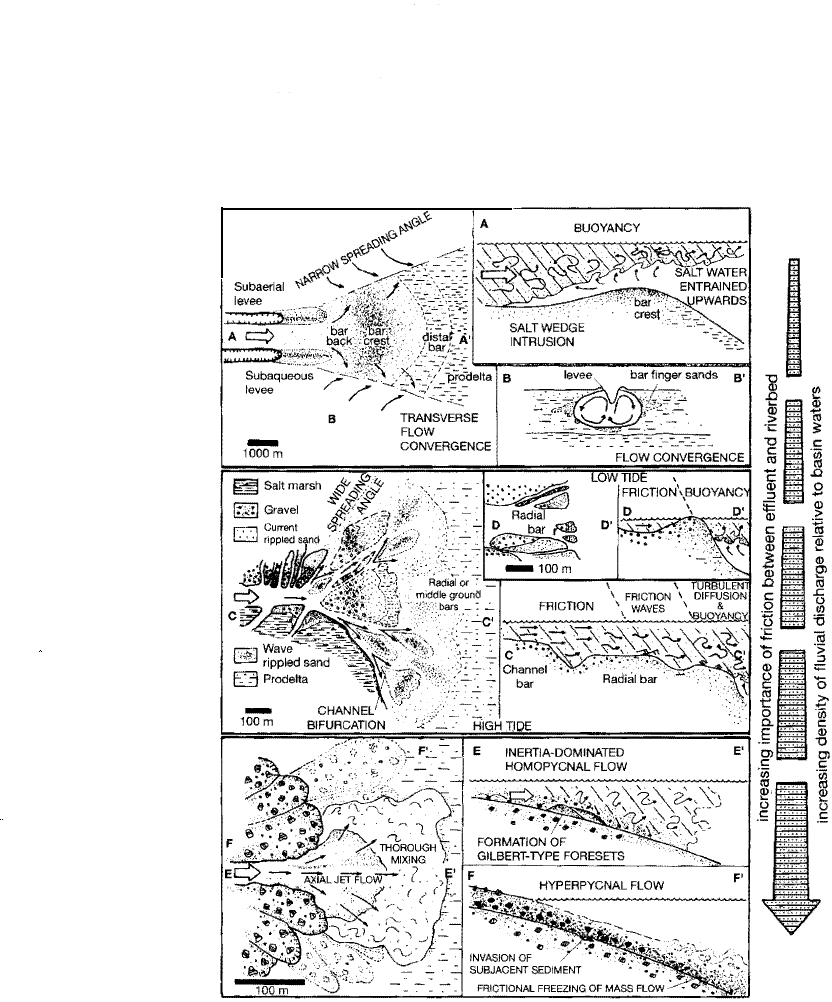
294
Chapter 9 1 Marginal-Marine Environments
Figure 9.5
Schematic depiction of the
complex relationship arising
from sediment grain size,
river outflow inertia
(veloci), outflow friction
with the bed, and outflow
buoyancy-and its effect on
delta formation. [After
Orton, G. j., and H. G. Read
ing, 1993, Variability of
deltaic processes in terms of
sediment supply, with partic
ular emphasis on grain size:
Sedimentology, v. 40, Fig. 4,
p. 487, reproduced by per
mission.]
(2) turbulent bed friction seaward of the river mouth, and (3) outflow buoyancy.
For example, outflows dominated by inertial forces produce narrow river-mouth
bars of the Gilbert type. Outflows dominated by turbulent friction generate trian
gular "middle-ground" bars and channel bifurcation, whereas buoyant outflow
leads to formation of elongate distributaries with parallel banks, called subaque
ous levees; few channel bifurcations; and narrow distributary-mouth bars that
grade seaward to fine-graed distal-bar deposits and prodelta clays. Bar sands or
bar-finger sands are typical components of such deltaic assemblages.
Orton and Reading (1993) extended Wright's work by further suggestg
that discharge processes and the nate of the river mouth cannot be considered
dependently of the sediment load and that mixing behavior at the river mouth
diers for suspended load, mixed load, and bedload chael types and for very
coarse grained, gravelly bedloads and mass-flow dominated alluvial regimes.
Bates' (1953), Wright's (1977), and Orton and Reading's (1993) concepts are com
bined in Figure 9.5, which graphically depicts the relationship between the kd of
sediment load d the type of outow dominant.
Buoyant dominated river mouths (Fig. 9.5A) form where the inflow extends
as a plume (hypopycnal flow) into relatively deep, generally marine, waters. e
flow detaches from the bed and is thus unable to move bedload beyond the de
tachment point (Reading and Collinson, 1996). Turbulent mixing is intense near
FINE
GRAINED
SUSPENDED·
LOAD
CHANNELS
(B)
SANDY
MIXED-LOAD
CHANNELS
(C)
GRAVELLY
BEDLOAD
or
MASS-FLOW
DOMINATED
CHANNELS
B'
A'
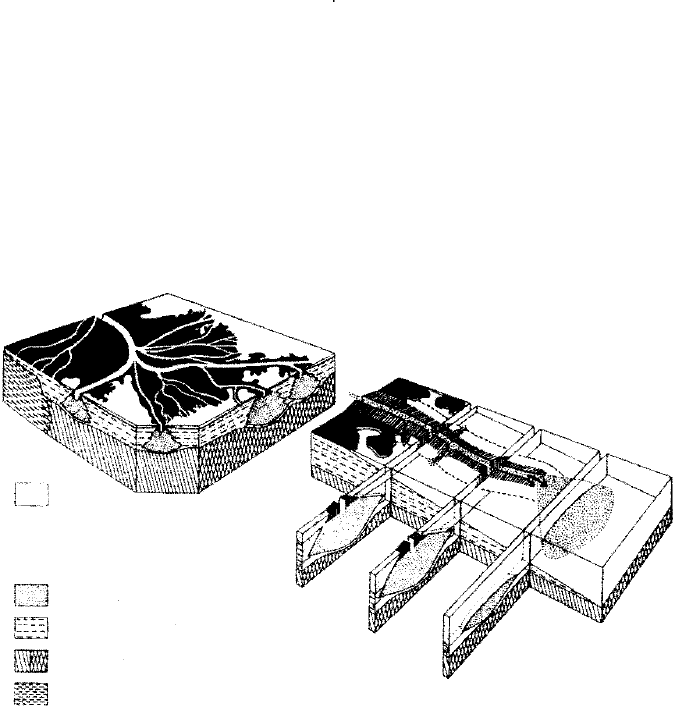
9.2 Deltaic Systems
295
the river mouth, and much of the coarser suspended and bed load is deposited,
whereas finer grained sediment is transported farther into the basin before depo-
sition. Note from Figure 9.5A the position of levees and bars and the presence of
bar-finger sands. Friction-dominated river mouths (Fig. 9.5B) occur where rivers
enter water so shallow that the inflow can expand only in a horizontal direction.
mu friction is present between the incoming flow and the sediment surface
that the inflow jet spreads laterall decelerates, and generates a iangular "middle-
und" bar in the river mouth and leads to charmel bifurcation. Inertia-dominated
ver mouths (Fig. 9.5C) form where the slope is steep enough to allow expansion
of the inflow in both the horizontal and vertical direction. This expansion com-
monly occurs where high-velocity rivers enter fresh water and I or carry substan-
al quantities of coarse sediment. Thorough mixing of the axial jet flow
(homopycnal flow) may cause rapid deposition of the bed load, leading to forma-
tion of Gilbert-type foresets, as mentioned; however, underflows (hyperpycnal
flow) may develop lateral to the axial jet that transports sediment as mass ows.
e modern Mississippi River delta is is a classic example of a birdsfoot
te, buoyancy-dominated delta. It is among the largest deltas in the world out
side of Asia (Table 9.1 ). The Mississippi delta consists of seven distinct sedimentary
lobes (Fig. 9.2) that have been active during the past 50006000 years, indicating
that periodic channel or distributary abandonment, to be discussed, is a common
ps. The generalized characteristics of the Mississippi delta system are shown
Figure 9.6. This figure illustrates the well-developed birdsfoot distributary sys
tem, typical of the delta, with bar-finger sands developed at the mouths of the dis
butaries. Common sediment facies on the Mississippi delta include marsh and
natural-levee deposits, delta-front silts and sands, and prodelta days. Other
mode deltas that are largely fluvial-dominated include the Mackenzie Delta
(Canada, Beaufort Sea) and the Alta delta (Norway, Alta Fiord), as indicated in
Figure9.3.
Tide-Dominated Deltas
The processes and deposits described above may be significantly modified under
nditions of high tidal range or high wave energy. If tidal currents are stronger
than river outflow, these bidirectional currents can redistribute river-mouth sedi
ments, producing sand-lled, funnel-shaped distbutaries. e distributary mouth
•
•
Water
Marsh
Natural levees
Bar� nger sand
Delta� front silts and sands
Prodelta s;Jty clays
Older sediments
Figure 9.6
The fluvial-dominated, Mississip
pi delta system. [From Reineck,
H. E,, 1970, Marine sandkirper,
rezent und fossil: Geol. Rund
schau, v, 60, Fig, 2, p., 305,
reprinted by permission. Origi
nally modified from Fisk, H. N.,
E. Mcfarland, C. R. Kolb, and l. ).
Wilbert, 1954, Sedimentary
framework of the modern Missis
sippi delta: jour. Sed. Petrology,
v.
24, Fig. 1, p, 77.)
